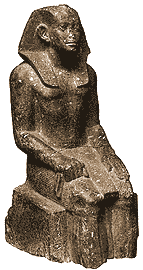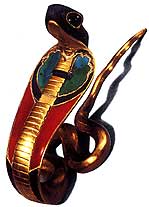 |
The son
and successor of Amenemhet II (co-regent for ~3 years), and like
his father he continued the policy of peaceful diplomacy with
Egypt's neighbours and to improve the economic and agricultural
standard of Egypt herself.
There
is no evidence that Sesostris II undertook any military campaigns,
it is perhaps of this peaceful climate that many foreigners undertook
to settle in Egypt (throughout the 12th and 13th Dynasties men
and women from Palestine and Syria ** arrived in Egypt at first
to work as servants in Egyptian houses, objects found at Kahun
(see below) show that they worked on Sesostris II pyramid both
as part of the main workforce and as temple workers - ** this
people are more commonly referred to in Egyptian history as the
'Asiatics').
|
Sesostris II and the
Faiyum
Although it was completed
by his grandson (Amenemhet III), Sesostris II began the great
land reclamation project at the Faiyum, it was also here that
he chose to build his pyramid (Lahun). A short distance away
from his pyramid, Sesostris II also built a temple and a 'pyramid
town' - the town was called 'Hetep-Sesostris' (Sesostris is satisfied)
- today it is called Kahun. More information about this town
can be found HERE.

| A - Pyramid |
E - Remains
of an offering chapel |
| B - Entrance |
F - Secondary
(Queen's) pyramid |
| C - Corridor |
G - Mastabas |
| D - Burial
Chamber |
H - Tomb
of SitHathoriunet |
|
|

The Royal Uraeus found
by Petrie in the pyramid, probably from Sesostris II's crown
or wig
|
�
The Pyramid
of Sesostris II was first entered by Petrie in 1880, however,
the changes to design made by Sesostris II to deter tomb robbers
made it impossible for Petrie to discover the entrance. Instead
he dug directly into the pyramid until he reached the roof block
of the burial chamber, to reach this spot Petrie had to tunnel
through sand in constant danger of collapse. Stone masons were
neeeded to dig through the granite stone into the burial chamber,
so Petrie spent his nights in the tunnel shoring up the sand
tunnel and repairing the tunnel were it had collapsed. Once the
burial chamber was opened (full of water) Petrie found the originally
entrance to the tomb by following the passages to the outside,
except the tunnels were filled with mud - this of course did
not stop Petrie, there was just enough room for him to slide
(stripped and lying on his back) through the various traps and
tunnels in the darkness, and fighting the mud, slime and poor
air until he emerged at the true entrance!
Petrie returned to the site in 1913, and together with Guy Bunton, made wonderfully discoveries in the tomb-shaft of Sithathoriunet.
|


